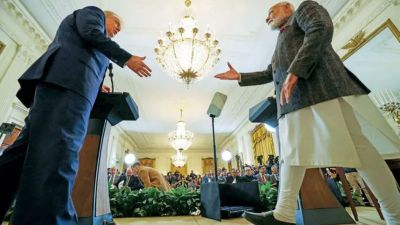Retinal injuries on rise due to exposure to intense DJ laser beams, say experts
‘Many patients develop blurred vision due to such lights at pubs, weddings, concerts, laser shows’
 While the state health department has not received any official complaints so far, nearly 10 cases have been reported across the state — five in Nashik, two in Dhule, and one each in Pune, Thane and Mumbai — this year. (Express file photo)
While the state health department has not received any official complaints so far, nearly 10 cases have been reported across the state — five in Nashik, two in Dhule, and one each in Pune, Thane and Mumbai — this year. (Express file photo) Ganesh Chaturthi festivities ended on a bleak note for five Nashik residents, aged between 25-30 years, whose vision has been affected permanently due to “exposure to intense and concentrated DJ laser beams”.
The retina, a sensitive tissue in the back of the eye that is essential for vision, can be harmed by high-powered, high-wavelength laser beams, especially green ones, an ophthalmologist said, adding that increasing use of lasers without proper calibration at pubs, weddings, concerts and even laser shows was leading to many instances of retinal injury. Often in the “visible or near-infrared range”, the doctor said lasers can cause intense heat when concentrated on a small retinal area, potentially causing burns and permanent vision problems. Dr Sachin Kasliwal of the Nashik Ophthalmologists’ Association said, “A young man turned up at the outpatient department recently complaining of vision problems since Ganesh Chaturthi. Preliminary examination revealed severe vision loss. Further examination showed substantial bleeding and injuries similar to burns on the retina.”
Queries by Dr Kasliwal revealed the patient had watched a laser show during the procession. “The young man had been exposed to laser beams, especially the green ones. These lasers damaged his retinas,” the doctor said. Stating that these are not isolated incidents, Maharashtra-based ophthalmologists said they have encountered multiple cases of individuals developing blurred vision due to exposure to laser lights at pubs, weddings, concerts and even laser shows.
While the state health department has not received any official complaints so far, nearly 10 cases have been reported across the state — five in Nashik, two in Dhule, and one each in Pune, Thane and Mumbai — this year. During Ganpati celebrations last year, nearly 65 people suffered from varying degrees of vision loss.
Explaining the different types of lasers, Dr Ganesh Bhamore, an ophthalmologist based in Nashik, said, “Exposure to Class-1 and Class-2 lasers, for instance, is relatively safer due to their low power levels or enclosed design, which prevents direct eye exposure.”
Stating that he has treated three patients for laser-induced retinal damage, Dr Bhamore said, “Class-1 lasers are most commonly found in consumer devices like laser pointers, while Class-2 lasers are found in barcode scanners. These emit visible light in the range of 400 nanometer (nm) to 700 nm.”
Talking about laser safety thresholds, he noted, “While 5 milliwatts is generally considered safe, 50 milliwatts fall within a moderately safe range. Exposure to laser beams exceeding these thresholds, especially when used improperly or at high intensities, can potentially cause severe harm to the eyes.”
Dr Amol Mhatre, an ophthalomologist from Thane, said he treated a 25-year-old man for blurry vision last month. “He had a blood clot. When we took his history, we discovered it was because of the laser used in the pub, which affected his peripheral vision,” he said.
Dr Shashi Kapoor, a former ophthalmologist at the government-run JJ Hospital, pointed to the growing prevalence of such incidents, particularly among the youth “who casually gaze into laser beams”. He shared, “I have treated patients who experienced retina damage from laser shows. In medical context, precise calibration is indispensable for procedures like laser eye surgery such as LASIK or treatments involving the retina. Now, imagine the consequences if someone were to gaze into an uncalibrated wavelength without protective goggles or safety barriers.”
The ophthalmology association plans to write to the health department to implement regulations to prevent such incidents. When asked about the impact of other stage lights on eyesight, Dr Kapoor explained that laser beams are highly intense and focused, resulting in a higher power density on the retina when compared to the broader, less focused beams of conventional stage lights.
“Prolonged or direct exposure to such intense laser beams, especially at shorter wavelengths, can potentially cause thermal damage to the retina, leading to conditions like laser-induced retinal damage. Stage lights, while bright, typically have a more diffuse and less concentrated output, reducing the risk of severe eye damage associated with lasers.”







